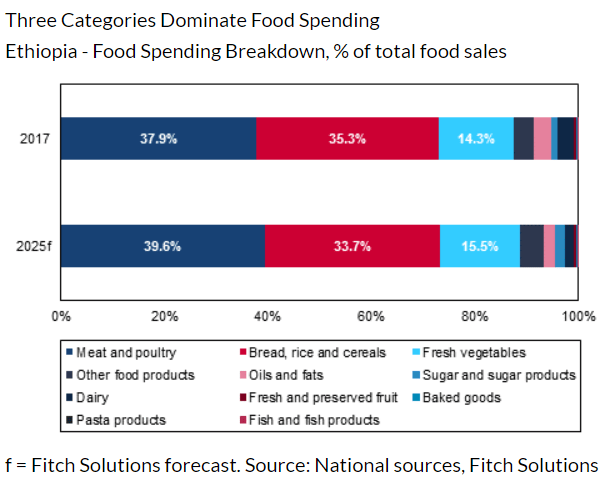Ethiopian households will allocate a projected 34.8 per cent of their household budgets to food in 2025, a decrease when compared to 42.9 per cent in 2017, Fitch Solutions affirms.
This indicates a diversification of household budgets as Ethiopian consumers increase their spending on other items beside food. Ethiopia’s GDP per capita is projected to reach US$1,048 in 2025, increasing from US$721.
According to Fitch, Ethiopian consumer’s incomes are low, therefore making them price-sensitive, even when spending on food products.
Based on this, Fitch Solutions forecasts food spending to grow by an average of 18.7 per cent over a forecast period of 2017-2025. Compared with inflation, food spending is 2.7 per cent higher, as inflation forecast averages 15.4 per cent over 2017-2025.
Moreover, Ethiopia’s food spending will mainly be concentrated on five food spending categories which are meat and poultry, bread, rice and cereals and fresh vegetables. This makes up 89 per cent of total food spending, increasing from 87.5 per cent in 2017.
“We project meat and poultry to make up 39.6 per cent of total food spending in 2025, increasing from 37.9 per cent in 2017 while fresh vegetables spending will increase to 15.5 per cent in 2025 from 14.3 per cent in 2017.”
Fitch
Meat is a key part of Ethiopia’s local diet. Spending for meat and poultry are forecast to reach US$12.3 billion in 2025 from US$7.9 billion in 2017. This represents an annual growth rate of 20.5 per cent over 2017-2025.

Staples to become popular food in 2025
Fitch projects poultry and pork to post the fastest spending growth over 2017-2025 with each of the categories expanding by 20.8 per cent. Spending on beef will also be strong, growing by 20.7 per cent over 2017-2025.
Furthermore, staples in bread, rice and cereals category will remain highly popular due to their affordability reaching US$10.5 billion in 2025 from USD7.3billion in 2017. This indicates an average annual growth rate of 17.6 per cent.
However, growth within this category will be slower than headline food spending growth of 18.7 per cent. Spending on this category is quite low, as a majority of these items are made at home, Fitch Solutions averred.
Additionally, sugar and sugar products category will outperform all other categories, expanding by an average annual growth rate of 23.7 per cent over the forecast period. In monetary terms, this volume spending will translate into spending value of US$546million in 2025 compared with US$235million in 2021.
Within the sugar and sugar products spending category, sugar dominates spending and will make up 95.4 per cent of total spending in 2025, increasing from 93.5 per cent in 2017. Sugar production in Ethiopia has historically been under the control of the government. However, the Ethiopian government has announced plans to privatize 10 out of its 13 sugar production facilities.
This will see further growth of Ethiopia’s sugar industry over the coming years. Likewise, Fitch notes that Ethiopia’s confectionery market is largely untapped and this presents significant opportunities for investors over the coming years.
READ ALSO: Existing Subnational Governance System to Delay Dev’t of Mining Comm’ties for Another ‘100 Years’























